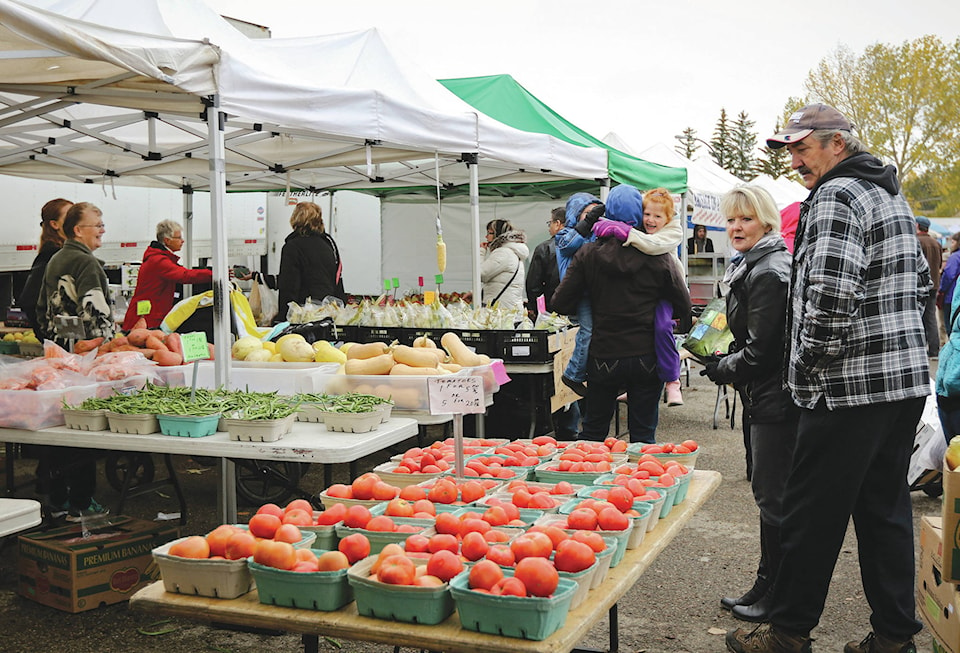According to the Alberta Government web site, over 72 per cent of households shop at farmer’s market with the average person spending between $35 and $55 a visit. This number has increased dramatically sense the inception of Farmer’s Markets in the 1970s.
All Farmer’s Market must abide by the rules or requirements set out by the government. All markets have similar rules that relate to health and safety but only farmer’s markets require more than 80 per cent of the items sold at the market to be home grown, homemade, or crafted by the vendor or family. Twenty per cent of the product for sale can be purchased elsewhere and resold. Markets that do not comply with the 80/20 rule are given two years to comply before they lose their status of a farmer’s market.
Flea Market items, live animals, uninspected meat, raw milk with the exception of cheese, hatching eggs or e-cigarettes are not to be sold at Farmer’s Markets.
Market activities are ran by a manager who then reports to a board or an advisory committee. It is the manager’s responsibility to see that all venders follow government and local rules.
When making a purchase at any market give it as much or more care and attention as one would in a grocery store. Inspect the product carefully and ask questions. Be informed. Just because it is homemade or home grown doesn’t guarantee quality. Just because it is sold at a farmer’s market doesn’t guarantee it was grown locally.
When buying produce or plants, look to see if it is fresh, crisp and clean. People usually put the same amount of care in growing the produce as they do preparing it. Clean produce shows pride in the end product.
Ask where crops are grown. Expect growers to be selling produce slightly earlier than what is available in the average garden as the market gardeners use tunnels, plastic mulch and covers are used to speed up the season.
Find out when the produce was harvested. Most local growers harvest the morning of the market or the night before.
Not so with produce brought in from BC. It will have traveled and been in storage for at least 24 hours before being sold. Definitely still fresher than what is available in stores but not as fresh as locally grown produce.
With a few exceptions, locally grown produce is seasonal.
Apples and pears are harvested in the fall. If they are being sold at markets earlier in the summer chances are that they have just been pulled out of storage.
If stickers are stuck to the fruits or vegetable chances are high that the produce was purchased through a whole sale company. Very few market gardeners have the time to apply stickers to their produce.
Plants should be healthy and free of pests. As the season progresses, expect plant roots to become packed into their containers making it harder to successfully transplant plants into the garden.
Home grown produce may or may not be organic. To sell items as organic the grower must apply for organic status which takes time and compliance.
There are stringent regulations that must be followed regarding when the last chemical was used on the land as well as a buffer between the organic land and areas where chemicals are used.
Organic produce must be grown without the use of synthesized chemicals, fertilizers or pesticides. Seed for or the organic market cannot be genetically modified.
Some venders will claim to be selling spray free produce. While a viable alternative for many market gardeners, it is not a regulated status but is a viable alternative.
Want to know who has the best produce at the market, look at the line ups.
The longest lines usually have the best produce.
Join the majority and visit a local Farmer’s market. The following link lists all Alberta’s Farmer’s Markets including directions and time of operation.
https://www.agric.gov.ab.ca/app21/rtw/markets/markets_map.jsp
Linda Tomlinson is a horticulturalist that lives near Rocky Mountain House. She can be reached at your_garden@hotmail.com
